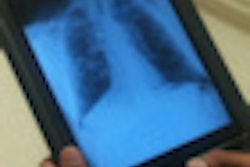While private radiology groups may find it convenient to farm out night and weekend call coverage to teleradiology firms, such outsourcing is contributing to the decline of radiology, according to an article published today in the February issue of the Journal of the American College of Radiology.
In their paper, David Levin, MD, and co-author Vijay Rao, MD, of Thomas Jefferson University in Philadelphia, make their case that teleradiology outsourcing contributes to the commoditization of radiology, lowered reimbursement, displacement from hospital and outpatient reading contracts, greater encroachment by other specialties, and lowered quality. They also share their opinions on what radiology groups should do about it.
"We want to try and wake up the radiology community to the fact that outsourcing night and weekend call poses a real danger to the future of the specialty ... and to suggest that they seriously consider taking back the responsibility for their own coverage," Levin told AuntMinnie.com.
Morphing predators?
While the teleradiology industry initially seemed to provide advantages to radiology practices, the situation has changed in recent years, according to the authors (JACR, February 2011, Vol. 8:2, pp. 104-108).
"Those friendly companies that were helping radiology groups with night call and subspecialty reads gradually morphed into predators bent on ousting those groups from their hospital contracts," they wrote.
The authors believe that radiology groups that outsource to teleradiology firms can create a host of real and potential problems, including contributing to the commoditization of radiology.
As noted in an article on commoditization and radiology by James Borgstede, MD, of the University of Colorado, four service components will be required for radiology to continue to be recognized as a specialty in future years:
- A pre-examination evaluation of the request for appropriateness and necessity
- Supervising and monitoring the examination to ensure its quality
- Exam interpretation
- A postexamination evaluation with the referring physician (and perhaps the patient as well)
Radiologists abdicate three of those four responsibilities by outsourcing to teleradiology companies, Levin and Rao wrote.
"What kind of a message does that send to our physician and hospital administration colleagues?" they wrote. "The message would seem to be that radiology is just a commodity and that radiologists are more concerned with their own convenience than with taking care of patients. Moreover, if the radiology group isn't indispensable at night, why should they feel they are indispensable during the day?"
Lower fees
The radiology community is facing the threat of falling reimbursements, both from government programs and commercial payors, according to the authors.
"Quite possibly, some of the impetus for this comes from the price wars the teleradiology companies have openly engaged in and the lower fees they are willing to accept," they wrote. "We even have the spectacle of a teleradiology company that auctions image reading contracts to the lowest bidder, thus further reinforcing the impression throughout the healthcare industry that radiology is nothing more than a commodity."
With teleradiology companies now actively involved in competing with incumbent radiology groups, there's no room for complacency; hospital administration may have plenty of reasons why they want to replace their radiology group, according to the authors.
Radiologists could also lose reading contracts with independent diagnostic testing facilities or for nonradiologist physicians who have installed imaging equipment in their offices, according to the authors.
"The owners of the equipment could potentially realize greater profits by contracting with a teleradiology company that would accept lower compensation," they wrote.
Inviting encroachment?
Levin and Rao noted that perhaps the best arguments for why radiologists should be given exclusive rights to handle most imaging modalities in a hospital are that they are the ones with the most training and experience, and that they have assumed the responsibility of providing the most complete and best possible imaging services of all types to patients in the hospital.
"The latter argument loses all credibility when radiologists abrogate this responsibility every night and weekend," the authors wrote. "If radiologists feel they are a crucial part of the patient care team only during normal business hours, why should other physicians or the hospital administration be willing to grant them exclusivity? Outsourcing would seem to create a surefire precedent under which radiologists will lose turf battles in the future."
Lowered quality?
The authors believe that there are a number of reasons why work done by radiologists at teleradiology companies may be inferior to that done by hospital-affiliated, onsite radiologists.
First, radiologists at teleradiology firms are expected to read studies as quickly as possible, since speed is of the essence, according to the authors.
"After all, that is the only way the companies can make money," they wrote. "The less time available to spend on each case, the more likely it is that mistakes will be made."
Also, teleradiologists at remote sites have little or no contact with referring physicians, which means they don't get input from clinical colleagues on the nature and nuances of the case, according to Levin and Rao.
Teleradiologists also have no contact with patients and have little or no access to other clinical information about the patient, according to the authors.
"While interpreting complex imaging studies in this kind of vacuum may be in the best interests of the company's bottom line, it is clearly not in the best interest of the patient," they wrote.
In addition, teleradiologists generally can't consult with colleagues about a difficult study. And radiologists learn by getting clinical follow-up on studies they've interpreted, according to the authors.
"This kind of feedback will be almost impossible to obtain when the reader is at a distant site," they wrote.
Teleradiologists are also not in the hospital department to protocol examinations, supervise the technologists, or answer questions, according to the authors.
"Finally, there is little or no oversight of an individual teleradiologist's performance by hospital quality assurance or risk management committees, or by a chairperson or senior member of the group," they wrote.
Recommendations
The authors recommend radiologists take a number of different steps. For starters, radiologists should cover their own practices 24/7, "just like in the old days before the easy-life mentality took over."
"Don't outsource night and weekend imaging to the teleradiology companies," they wrote. "Without the business we give them voluntarily, they will cease to exist. This will not be easy, but it must be done if we hope to remain a respected and well-compensated specialty, rather than a commodity."
The authors also recommend that radiologists not work for teleradiology firms, even on a part-time basis.
Small radiology groups should also consider a few options to achieve the advantages of outsourcing without actually dealing with teleradiology companies, they wrote.
For example, consolidating into a single larger group would allow for night call to be spread around, therefore making it more tolerable. This enlarged group would also be more likely to have subspecialty expertise, the authors noted.
Another option could be for groups to remain separate, but work out a cooperative arrangement to share night and weekend call.
"Teleradiology is a great technology that affords this kind of opportunity for groups to work together in one aspect of practice, even though they might compete in others," the authors wrote.
Private groups could also form creative partnerships with academic radiology departments in their state to cover night and weekend cases, as well as provide subspecialty consultations or overreads, according to the authors.
"Academic departments all have subspecialized radiologists, and some now have emergency radiology sections that cover nights and weekends and could possibly take on more work," they wrote.
While it might seem a tall order for radiology practices to reverse course and turn their backs on outsourcing night and weekend call coverage to teleradiology companies, Levin believes it can absolutely be done.
"All it takes is the dedication and resolve to do it," Levin told AuntMinnie.com.
By Erik L. Ridley
AuntMinnie.com staff writer
February 1, 2011
Related Reading
Fostering radiologist-clinician relationships in the age of PACS, January 18, 2011
Personal touch can improve relationships with referring docs, July 20, 2010
PACS: A culprit in radiology commoditization? June 9, 2010
Virtual radiology: How does it affect knowledge transfer? May 25, 2010
The Profit Center: Part 13 -- Radiology as factory work? April 13, 2010




















